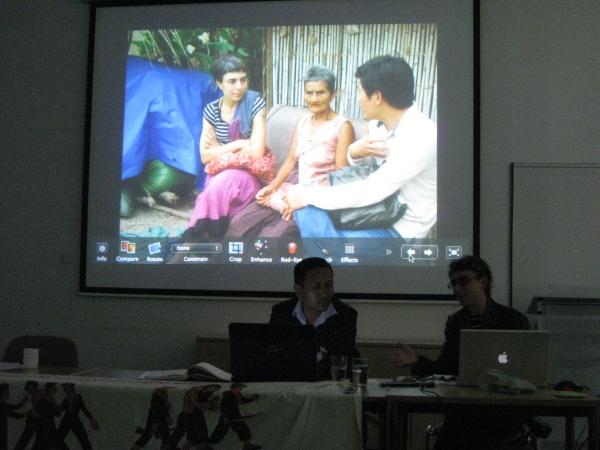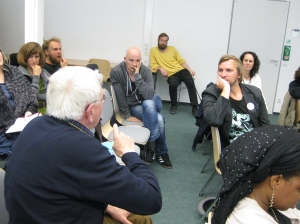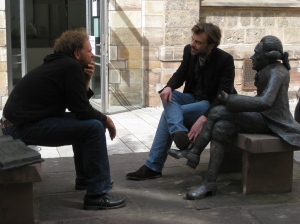Not too long ago I was fortunate enough to be invited to be a discussant at the Göttingen Ethnographic Film Festival Symposium, Participatory – what does it mean? Participatory cinema and participatory video under consideration. Participatory is a word we hear with increasing frequency in visual anthropology, particularly in relation to filmmaking (indeed I have used and written about participatory video on this blog). But the word is often bandied about with little consideration to what it actually means, either in theory or in practice.
![We Want [U] to Know presentation at GIEFF Nou Va and Ella Pugliese (film-makers) talk about the participatory process](https://ukvisualanth.files.wordpress.com/2012/07/img_0297.jpg?w=300&h=225)
Film-makers Nou Va and Ella Pugliese discuss their use of participatory methods in their film ‘We Want [U] to Know’
During the GIEFF symposium we spent three days talking about this term, and its practical applications. Turns out there is almost no consensus on how the term is used, with just about everyone using and understanding the term differently: from hardcore believers who advocate no input in the video / film-making process themselves, to others whose use of the term relates only to their seeking feedback from certain participants. To still others anything anthropological is participatory, because anthropological knowledge is built through intersubjective relations with others, and thereby participatory in their very nature. Neither did we come to a consensus on the term during the three days. But we did have a lot of interesting debates, some of which were fairly energetic, particularly those concerning whether the methods robust enough to be used in academic research?
Participatory video and participatory cinema essentially have two different theoretical foundations, but as time goes on and their popularity grows, the terms are becoming increasingly blurred. Evolving out of Development, Participatory Video (PV) is about working as a group to solve a problem. It assumes an issue to be dealt with, and insists on limited or no video-making from the ‘facilitators’, but on all elements of the video-making process being done by the participating community. But there are many issues caught up in these assumptions: to assume a problem in a community inevitably creates one, although it may not be the one that is the most important or pressing to various people in the group. To assume that a group or a whole community is inherently honest, cohesive and homogenous is both unrealistic and problematic. To insist that communities would be video-making if only they knew how, and we are the ones who can teach them that is both paternalistic and derogatory.
Participatory cinema meanwhile was a term initially developed by David MacDougall in opposition to Observational Cinema: participatory cinema encouraged an active participation from the film’s subjects, although mostly with the control being maintaining by the director / film-maker. It shares some intellectual concepts of Jean Rouch’s ‘shared anthropology’, not least in that in reality the levels of participation are somewhat limited and in some cases appear to be more a wave in the direction of a contemporary buzzword.
Narratives on participatory methods tend to be celebratory. Many filmmakers and researchers (myself included) have been somewhat over simplistic in their discussions on the subject, and whilst the positive aspects of the methods have been repeatedly emphasised, there is almost no critical discourse on the subject. It does exist (for example Wheeler’s (2009) article on her work in Brazil outlined several issues) but it is hard to find. One of the subjects that repeatedly arose throughout the symposium was the potential of participatory methods in anthropological research. Anthropology is about learning about other peoples’ worlds. This might be explored through participatory methods, but can we really learn the intricacies and nuances of life in a group? Anthropological knowledge is built on intimate relationships of trust, which are invariably built up one-to-one. How do you build trust and intimacy in a group? How can you avoid ‘invisible’ power relations from acting? Can you get to the discords that are so telling about informants’ lifeworlds? What about the missing voices: who doesn’t take part and why? Do participatory methods encourage a simplified version of events that ignores the complex nuances of community issues? Is a film made using participatory methods really any more ‘honest’ and ‘authentic’ than a more traditional film? What effect does the participatory method have on the actions and attitudes of the community?
The disjunctures that inevitably exist within communities, and the nuanced complexities of life are rarely (if ever) made apparent in participatory film or video, which almost exclusively present communities as cohesive, homogenous groups with shared aims and desires. As anthropologists we should be careful of presenting such simplified stories. On the other hand, good anthropology includes reflection by the researcher on their position, assumptions, presentation of the other, and effect on the research. Participatory methods potentially help this reflection, especially where participants have active control of the media: by enabling people to present themselves, participatory methods encourages the researcher to question their presentation of others, and it potentially can encourage a more collaborative, inter-subjective building of knowledge. In addition, using methods such as PV may allow us to align our research interests with the concerns of the community, which is an ideal ethical position.
To really explore the potential of PV as a research tool we need to push beyond the celebratory nature of most presentations and critically analyse both the potentialities for use, and our motivations for using it. We need to avoid the assumptions and paternalistic approach that so often accompany discussions on participatory methods: that they avoid hierarchy and power relations; that the story heard is the most important one; that everyone who wants to be involved is able to; that visual methods are the best (or automatically culturally appropriate) mode of exploration.
This post may sound extremely critical of the use of participatory methods. That’s not my aim: I think there is a strong potential in their use both as a research tool and as a means of encouraging collaboration and a more engaged, public anthropology. But before unquestioningly adopting these methods, we have a duty to ourselves, our discipline and, more importantly, to our participants to question our motivations behind their adoption, and to assess their place in our work. Only when we have asked these questions of ourselves, and addressed our concerns, should we jump in to participate.




who wrote this? very interesting and very useful.
A long delay in replying, but I wrote it Simon (Caroline Bennett)